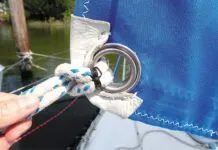WATER HEATER MYSTERY SMELL
I just read your Waypoints blog post “Hot Water Heater Installation Tips,” and wanted to share my experience. I recently installed a 6-gallon Kuuma 120VAC/engine heat-exchanger type water heater. I typically fill my water tanks in the spring and once or twice again throughout the summer as needed. I use well water to fill my water tanks but filter all the water through a Culligan 5-micron filter as I fill the tanks. I then treat the tank with bleach and hit it with a Camco TastePure water purifier, even though we don’t drink the water. I make sure to open the taps briefly each time I’m on the boat just to keep things stirred up a bit.
The problem usually starts two or three weeks into the season. The hot water starts to turn foul, emitting a heavy sulfur smell when you run it, even with the water heater off. It can get so bad that you can’t be in the head when you turn the hot water on or you’ll be coughing so bad you can’t breathe. Not a pleasant shower experience to say the least.
Based on my research, there are two possible causes. One camp says that the water you put into the tank is inherently gross, and I should add bleach to the hot water tank every couple of weeks or I will grow all kinds of critters when the water heats up. When it cools off the critters die, and this decomposing biomass is what generates the sulfur smell. My water is treated when it comes onboard, so I doubt this is the problem.
The other camp says the smell is due to some kind of galvanic reaction from the dissimilar metals in the water heater and other components. Their advice is to replace my drain valve with a suitable anode (I use magnesium in our freshwater environment) and this will mitigate the problem.
Well, I replaced my drain valve with an anode, and the following year, as best as I recall, I did not have a sulfur problem. But the next season, the smell came back with a vengeance. When I removed the anode to check its condition, I found that it had hardly deteriorated.
This season decided to add a bypass valve to the engine coolant input on the front of the water heater inlet, so I would be able to choose whether I need the water heated or not. This would stop the constant heating of otherwise stagnant water. When I tipped the water heater on its end, a half-gallon or so of retained liquid inside poured out. It was like milk.
Do you have any insight into what is causing this?
Don Lincoln
SV Nancy Lynn
1993 Catalina 36 MK1.5
Monroe, MI
The source of the odor is not critters, but sulfur in the water leached from the ground. Gypsum, for example, is calcium sulfate, and some of this dissolves into the water, depending on pH. A calcium sulfate content of 100–200 parts per millimeter is common. If the sulfur remains in this oxidized state it is harmless, tasteless, and odorless. However, if it is chemically reduced to sulfide (rotten eggs odor) just a few ppm will make it nasty.
The reduction can be caused by tiny amounts of harmless bacteria that can use sulfate as an oxygen source when oxygen isn’t available. The by-product of this metabolic path is sulfide. If the water is chlorinated, this will kill the bacteria and oxidize the sulfide to sulfate. But if the water sits warm, the chlorine will be cooked out of the water and the bacterial pathway will resume. If any of the bacteria survive, they’ll proliferate. Treating every water tank fill with bleach should solve the problem. Wells near waterways are drilled into sediments and are commonly high in sulfate.
Chemical reduction can also be galvanic, common when an anode is either exhausted or incorrectly wired (it sounds like yours is not working). A low-voltage leak into hot water heater from the engine is another possible cause. In fact, circulating engine coolant can generate a small current. The water heater should be grounded to the engine. If your boat does not yet have a galvanic isolator, separating the 120V ground from the sea ground, you might consider adding one. There could be a slight difference in ground potential from many sources, resulting in a ground loop, though in this case I would expect damage to props and through hulls.
In our view, either (or both) of these causes of chemical reduction could be occurring in the tank, but we suspect the former—some hardy bacteria that is surviving in your tank. Your bypass loop should help, as should your pre-chlorination (the TastePure is 12-percent chlorine, by the way). Keep us posted after this season.




































